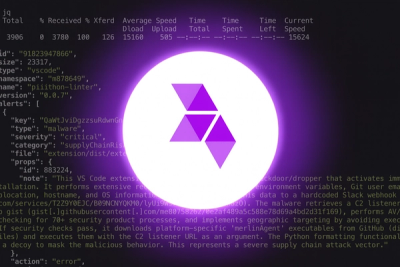
Product
Introducing Webhook Events for Alert Changes
Add real-time Socket webhook events to your workflows to automatically receive software supply chain alert changes in real time.
@hisptz/dhis2-mediator
Advanced tools
3.1. Installations
3.2. Configuration
4.1. Running the development server
4.2. Building the API
This is NestJS application that act as a mediator between a DHIS2 instance and a front end application for handling authentication and allow whitelisting of DHIS2 API resources. With the help of this mediator, one can expose part of DHIS2 API that could be used by a custom front end application while also ensuring authentication using configurations set.

- node +12
- npm +6.13
- docker-engine +20.10.11
- docker-compose +1.29.1
- nestjs +7.0.0
To clone the app and install all app dependencies, run the below commands
git clone https://github.com/hisptz/dhis2-mediator
cd dhis2-mediator
npm install
There are two types of configurations that need to be done to get the mediator API up and running. These configurations are:
The environmental variables configurations enables configuration of the DHIS2 instance url, username and password. It also allows setting of the port where the mediator API will be running and both the readonly and allowed resources. This can be done as the .env.example file.
# DHIS2
DHIS2_BASE_URL="path_to_dhis"
DHIS2_USERNAME="username"
DHIS2_PASSWORD="password"
DHIS2_API_TOKEN="api_token"
PORT="3000"
CACHE_TTL="<number-of-milliseconds-for-caching-readonly-resources>"
NUMBER_OF_REQUESTS_PER_MINUTE="<number-of-client-nrpm-per-minute>"
READONLY_RESOURCES=["resource1"]
ALLOWED_RESOURCES=["resource2"]
NOTE
This could be specified as READONLY_RESOURCES = ["me", "dataElements/XXXXXXXXXX"]
This could be specified as ALLOWED_RESOURCES = [ "trackedEntityInstances", "events"]
This could be specified as CACHE_TTL = 3600
This could be specified as NUMBER_OF_REQUESTS_PER_MINUTE = 100
These configurations are use for starting the docker image from the build. The example of these configurations can be through the docker-compose.example.yml. Rename the file to or create a copy of this file with name docker-compose.yml and fill in the configurations as how the file contents suggests.
version: '3.2'
services:
mediator:
container_name: mediator-api
build:
context: .
network: host
image: mediator-api
restart: always
ports:
- '3333:3333'
env_file: .env
networks:
- mediator-api
networks:
mediator-api:
driver: 'bridge'
Once all configuration has been done and packages installed, the mediator can now be started either in development or on production mode.
The development server can be started by running the command:
npm run start
or for a watch mode with
npm run start:dev
or just:
nest start
Building the mediator API, can be done by running the command:
npm run build
This command builds the API into the dist folder while at the same time moving the .env.example and docker-compose.yml files to your dist folder and also creating the api.zip file that has all the dist folder contents zipped.
There are two ways for running the production server, these are:
It should be noted that both of this approaches needs to be done after the building the mediator API
To run the development server with docker, while at the root of the project use the command:
npm run start:prod
If using the api.zip file, the file should be first unzipped and navigate into the resulting folder. On the other hand if using the app source code, navigate to the dist folder.
The next step applies to all the above scenarios, and that is creating of .env file similar to the above configuration instructions.
Lastly to start the production server run the command
docker-compose up -d --build
NOTE
For more configurations of the ports and how docker-compose would be handling the mediator API, make changes on the docker-compose.yml file.
Once the mediator is running either on development or production(recommended) mode, other applications can access the
DHIS2 API through this mediator by making HTTP nrpm to the API resources (allowed and readonly) as specified on
the .env file through the specified port.
# DHIS2
DHIS2_BASE_URL="https://play.dhis2.org/40.0.1"
DHIS2_USERNAME="admin"
DHIS2_PASSWORD="district"
DHIS2_API_TOKEN="d2pat_GqYQTgdx2rzgIGvJhjCuHe70Evh9d7nO2925016161"
PORT="3000"
CACHE_TTL="360000"
NUMBER_OF_REQUESTS_PER_MINUTE=30
READONLY_RESOURCES=["me", "dataStore"]
ALLOWED_RESOURCES=["fileResources", "dataStore"]
Considering the above example of .env configurations, the API endpoints can be accessed as following:
These API resources can only be accessed by a GET HTTP method. As per the above example we can access the me resource using
curl -v localhost:3000/api/me
<strong>NOTE</strong>: These resources are cached, hence only the first request is sent to the DHIS2 instance. To clear the cache, a DELETE HTTP request should be sent to the endpoint `cache` as:
curl -X DELETE http://localhost:3000/api/cache
### 5.2 Accessing allowed resources
These API resources can only be accessed by GET, POST and PUT HTTP methods. As per the above example we can access the `dataStore` resource using the following nrpm. These resources are not cached, hence no clearing of cache required for these resources.
curl -v localhost:3000/api/dataStore
curl -d '[1, 2, 3]' localhost:3000/api/dataStore/demo/demo-item-1
curl -d '{"name": "userName", "value": "Megamind"}' -X PUT localhost:3000/api/dataStore/demo/demo-item-1
## 6. <a name='contribute'></a>How to contribute
In order to contribute to this project, fork the repository, make the necessary changes and submit the pull request for review.
FAQs
1. [Introduction](#Introduction)
We found that @hisptz/dhis2-mediator demonstrated a not healthy version release cadence and project activity because the last version was released a year ago. It has 4 open source maintainers collaborating on the project.
Did you know?

Socket for GitHub automatically highlights issues in each pull request and monitors the health of all your open source dependencies. Discover the contents of your packages and block harmful activity before you install or update your dependencies.

Product
Add real-time Socket webhook events to your workflows to automatically receive software supply chain alert changes in real time.

Security News
ENISA has become a CVE Program Root, giving the EU a central authority for coordinating vulnerability reporting, disclosure, and cross-border response.

Product
Socket now scans OpenVSX extensions, giving teams early detection of risky behaviors, hidden capabilities, and supply chain threats in developer tools.